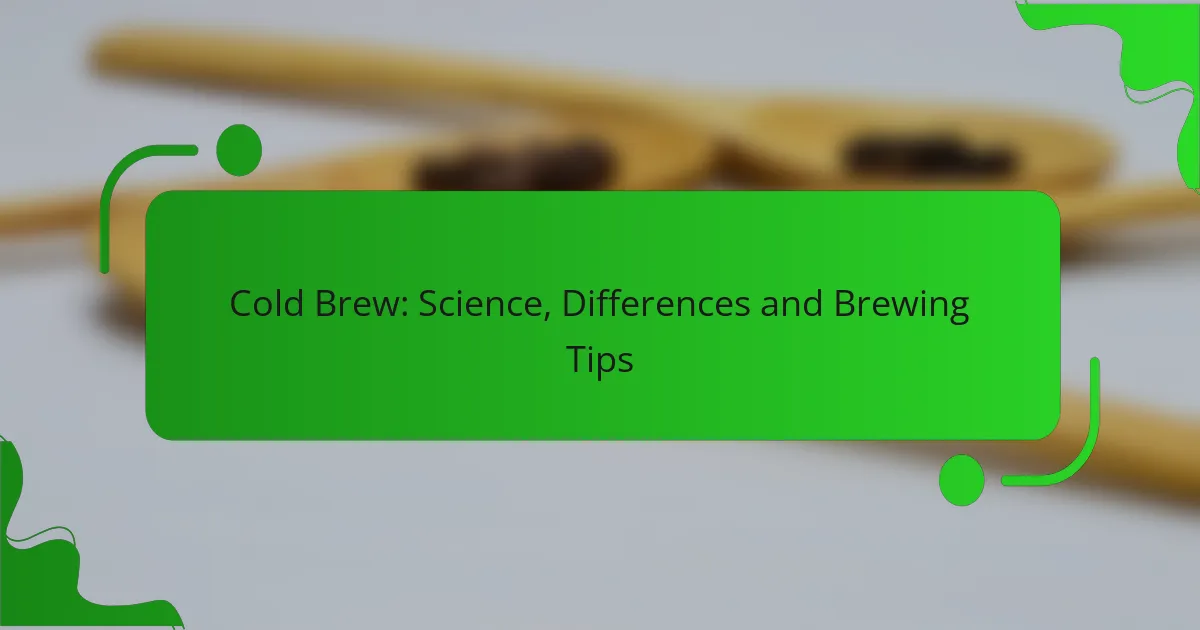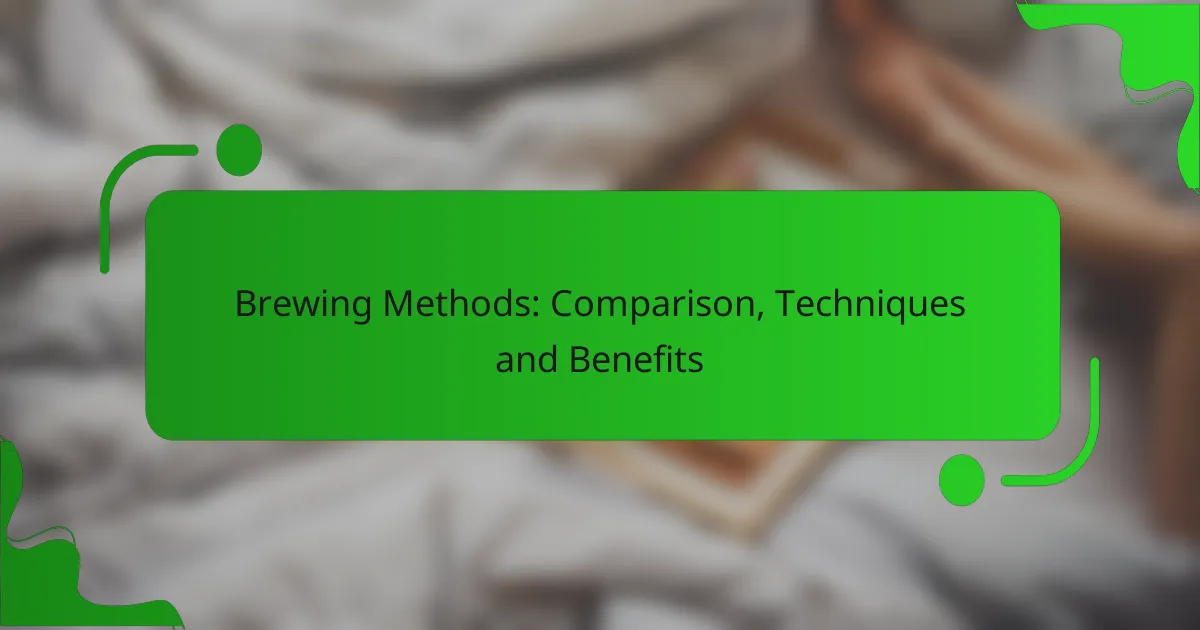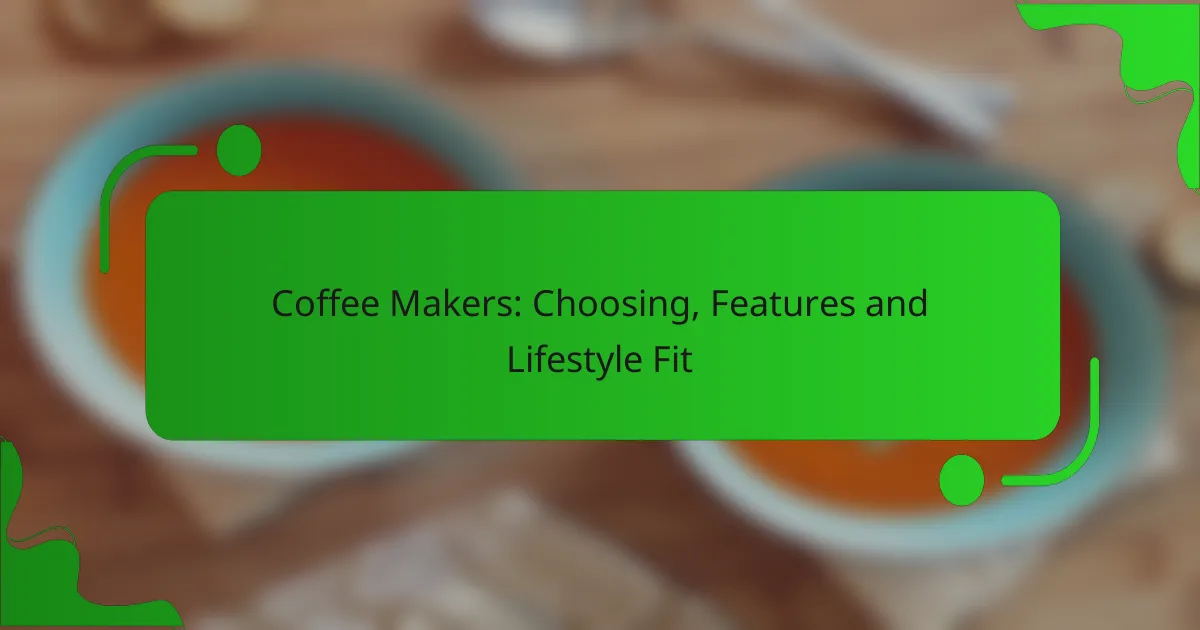Pour-over coffee is a meticulous brewing method that emphasizes precision and control to maximize flavor extraction. By carefully selecting equipment, adjusting water temperature, and fine-tuning grind size and pouring technique, you can significantly enhance the quality of your cup. Understanding the extraction process is essential, as it balances sweetness, acidity, and bitterness to create a rich and enjoyable flavor profile.

What are the best pour-over coffee techniques?
The best pour-over coffee techniques focus on precision and control to enhance flavor extraction. Key factors include the choice of equipment, water temperature, grind size, and pouring method, all of which significantly influence the final cup quality.
Pour-over methods: Chemex and Hario V60
The Chemex and Hario V60 are two popular pour-over methods, each offering distinct brewing experiences. The Chemex uses a thicker filter, resulting in a cleaner, brighter cup, while the Hario V60 allows for more control over the brewing process, making it easier to adjust variables like flow rate and extraction time.
When choosing between them, consider your taste preferences and desired brewing style. The Chemex is ideal for serving multiple cups at once, while the Hario V60 is better suited for single servings and experimentation.
Water temperature and grind size
Water temperature and grind size are crucial for optimal extraction in pour-over coffee. The ideal water temperature typically ranges from 90°C to 96°C (194°F to 205°F). Using water that is too hot can lead to over-extraction, while water that is too cool may result in under-extraction.
Grind size should be adjusted based on the brewing method; for the Hario V60, a medium-fine grind is recommended, whereas the Chemex benefits from a coarser grind. Experimenting within these ranges can help you find the perfect balance for your taste.
Brewing time and pouring technique
Brewing time for pour-over coffee generally falls between two to four minutes, depending on the method and grind size. A longer brewing time can enhance extraction but may also introduce bitterness if overdone.
Pouring technique plays a vital role in achieving even saturation of the coffee grounds. Start with a gentle spiral pour to bloom the coffee, then continue pouring in a controlled manner, avoiding the edges of the filter. This ensures consistent extraction and a well-balanced flavor profile.
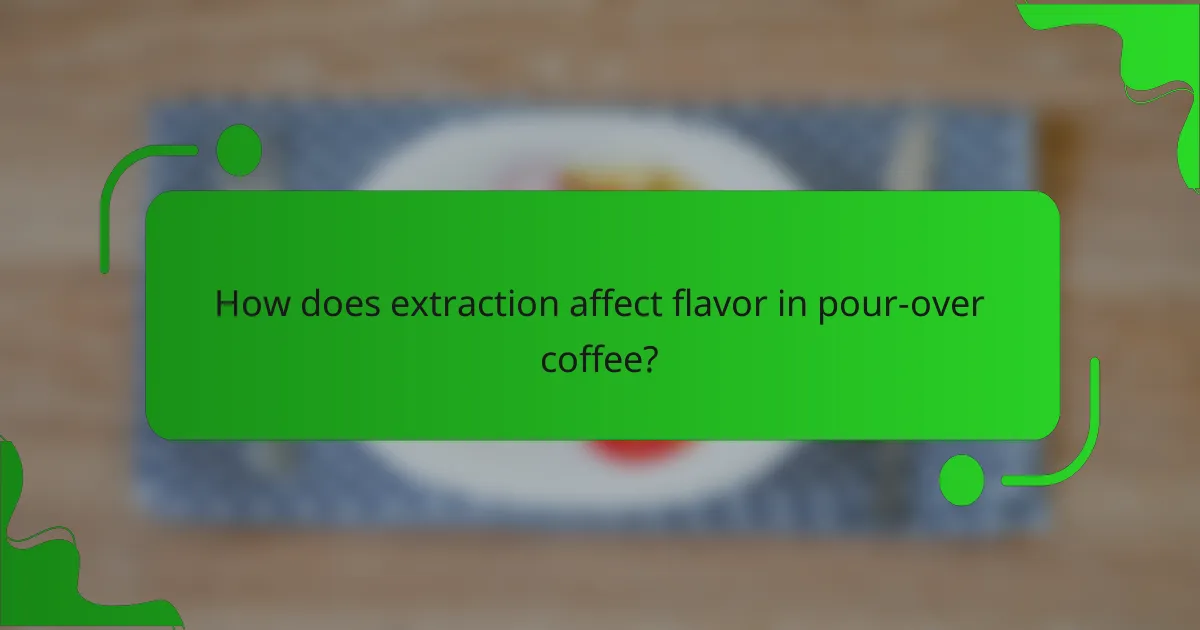
How does extraction affect flavor in pour-over coffee?
Extraction significantly influences the flavor profile of pour-over coffee by determining which compounds are dissolved from the coffee grounds. Proper extraction balances sweetness, acidity, and bitterness, leading to a more enjoyable cup.
Understanding extraction levels
Extraction levels refer to the degree to which coffee solubles are dissolved during brewing. Under-extraction can result in sour, weak flavors, while over-extraction may lead to bitterness and astringency. Ideal extraction typically falls within a range of 18-22% of the coffee’s mass.
To achieve optimal extraction, factors such as grind size, brew time, and water temperature must be carefully controlled. For instance, a finer grind increases surface area, enhancing extraction speed, while a coarser grind slows it down.
Impact of water quality on extraction
Water quality plays a crucial role in the extraction process, as it affects how well coffee solubles dissolve. Hard water, which contains high mineral content, can enhance extraction, while soft water may lead to under-extraction. Ideally, water should have a balanced mineral composition, with a total dissolved solids (TDS) level around 150-250 mg/L.
Using filtered or bottled water can improve the taste of pour-over coffee by reducing unwanted flavors from tap water. It’s advisable to avoid distilled water, as it lacks minerals that contribute to flavor extraction.

What equipment is needed for pour-over coffee?
To brew pour-over coffee, you’ll need a few essential pieces of equipment that ensure proper extraction and flavor. The key items include a kettle, a scale, and filters, each playing a crucial role in the brewing process.
Essential tools: kettle, scale, and filters
A gooseneck kettle is ideal for pour-over coffee as it allows for precise control over the water flow and temperature. Look for models that can heat water to around 90-96 degrees Celsius, which is optimal for coffee extraction.
A digital scale is important for measuring both coffee grounds and water accurately. A common ratio is about 1:15, meaning for every gram of coffee, use 15 grams of water. This helps achieve a balanced flavor profile.
Filters are necessary to separate the coffee grounds from the brewed coffee. Paper filters are widely used, but metal filters can offer a different texture and flavor by allowing more oils to pass through. Choose filters that fit your dripper model for the best results.
Recommended brands: Bonavita and Kalita
Bonavita is known for its reliable kettles and coffee makers that simplify the pour-over process. Their kettles often feature temperature control and a gooseneck spout, making them user-friendly for beginners and experts alike.
Kalita offers a range of drippers and filters that are praised for their design and functionality. The Kalita Wave dripper, for instance, has a flat-bottom design that promotes even extraction, making it a favorite among coffee enthusiasts.
Both brands provide quality equipment that can help elevate your pour-over coffee experience, ensuring consistent results and rich flavors with each brew.

What are the common mistakes in pour-over coffee brewing?
Common mistakes in pour-over coffee brewing can significantly affect flavor and extraction. Key errors include using the wrong grind size and failing to control water temperature, both of which can lead to under-extraction or over-extraction of coffee.
Incorrect grind size
The grind size of coffee beans is crucial for optimal extraction during pour-over brewing. A grind that is too coarse can result in weak, under-extracted coffee, while a grind that is too fine may lead to bitterness from over-extraction.
For pour-over methods, a medium grind is typically recommended, similar to granulated sugar. Adjusting the grind size based on your brewing time can also help; for example, a finer grind may be suitable for shorter brew times, while a coarser grind works better for longer brews.
Poor water temperature control
Water temperature plays a vital role in the extraction process of pour-over coffee. Ideally, water should be between 195°F and 205°F (90°C to 96°C) for optimal extraction. Water that is too hot can scorch the coffee, while water that is too cool can lead to under-extraction.
To maintain proper temperature, consider using a kettle with a built-in thermometer or a temperature-controlled kettle. Allowing the water to rest for about 30 seconds after boiling can also help achieve the right temperature for brewing.
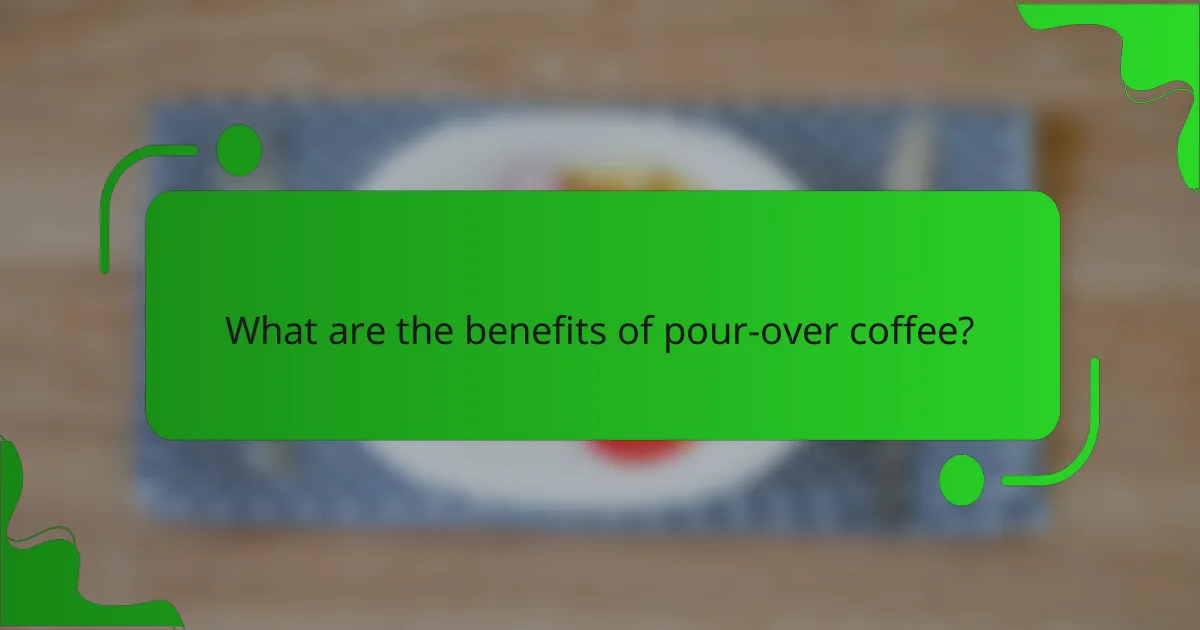
What are the benefits of pour-over coffee?
Pour-over coffee offers distinct advantages, particularly in flavor and brewing control. This method allows for a more nuanced taste profile and the ability to fine-tune various brewing parameters.
Enhanced flavor clarity
Pour-over coffee is renowned for its ability to highlight the unique flavors of the beans. The slow extraction process allows for a more even saturation of the coffee grounds, which can enhance the clarity of different tasting notes.
By using a filter, pour-over methods can reduce sediment and oils, resulting in a cleaner cup. This clarity makes it easier to discern subtle flavors, such as fruity or floral notes, which might be masked in other brewing methods.
Control over brewing variables
One of the key benefits of pour-over coffee is the level of control it provides over brewing variables, such as water temperature, grind size, and pour rate. Adjusting these factors can significantly impact the final flavor of the coffee.
For example, using water between 195°F and 205°F (90°C to 96°C) is generally recommended for optimal extraction. Additionally, experimenting with different grind sizes can help achieve the desired strength and flavor profile, with coarser grinds yielding a milder taste and finer grinds producing a bolder cup.
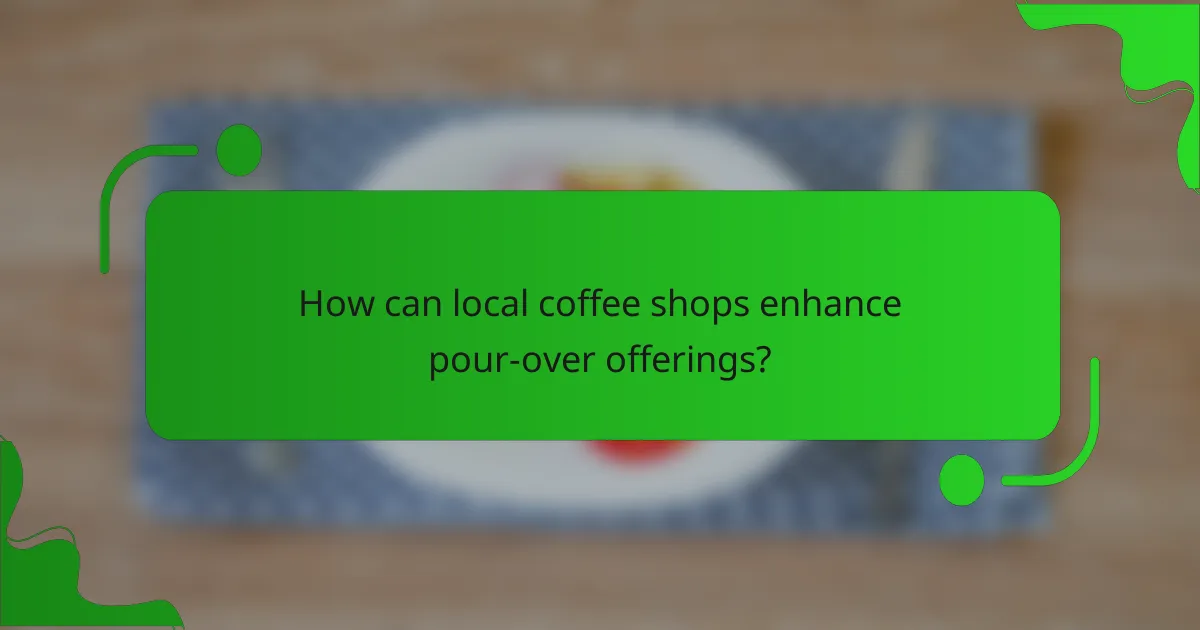
How can local coffee shops enhance pour-over offerings?
Local coffee shops can enhance their pour-over offerings by focusing on staff training and sourcing unique single-origin beans. These strategies not only improve the quality of the coffee but also create a more engaging experience for customers.
Training staff on techniques
Effective training is essential for staff to master pour-over techniques. This includes understanding grind size, water temperature, and pouring methods, which all significantly affect extraction and flavor. Regular workshops can help staff refine their skills and stay updated on best practices.
Consider implementing a standardized training program that covers the fundamentals of pour-over coffee, including the use of various brewing equipment. Encourage staff to experiment with different techniques to discover what works best for your specific beans and customer preferences.
Offering unique single-origin beans
Sourcing unique single-origin beans can set a coffee shop apart from competitors. These beans often have distinct flavor profiles that reflect their growing region, providing customers with a diverse tasting experience. Highlighting these origins can also create a story that engages customers.
When selecting beans, consider partnering with local roasters who prioritize quality and sustainability. Offering a rotating selection of single-origin coffees can keep the menu fresh and encourage customers to try new flavors. Additionally, providing tasting notes can help customers appreciate the nuances of each brew.

What are the trends in pour-over coffee for 2024?
In 2024, pour-over coffee trends are shifting towards sustainability, innovative brewing techniques, and enhanced flavor profiles. Coffee enthusiasts are increasingly prioritizing ethically sourced beans and experimenting with various brewing methods to achieve unique taste experiences.
Focus on Sustainability
Sustainability is becoming a key focus in the pour-over coffee scene. Many consumers are seeking beans that are certified organic or fair trade, ensuring that their coffee is not only high quality but also ethically sourced. Brands are responding by offering more transparency about their sourcing practices and environmental impact.
Additionally, eco-friendly brewing equipment is gaining popularity. Reusable filters and biodegradable materials are being favored over single-use options, aligning with the growing environmental consciousness among coffee drinkers.
Innovative Brewing Techniques
New brewing techniques are emerging, with many coffee aficionados experimenting with methods like the “Japanese style” pour-over and the “Siphon” method. These techniques often emphasize precise control over water temperature and flow rate, allowing for greater customization of flavor extraction.
Moreover, advancements in technology are influencing pour-over methods. Smart kettles with temperature control and timers are becoming more accessible, helping users achieve consistent results with minimal effort.
Enhanced Flavor Profiles
In 2024, there is a noticeable trend towards exploring diverse flavor profiles in pour-over coffee. Baristas and home brewers are increasingly using single-origin beans to highlight unique tasting notes, such as fruity or floral undertones. This trend encourages drinkers to appreciate the nuances of different coffee varieties.
Additionally, flavor pairing is gaining traction, with coffee enthusiasts experimenting with complementary flavors, such as spices or citrus, to enhance their pour-over experience. This approach not only enriches the tasting experience but also encourages creativity in coffee preparation.

